Photography and Zen - Japanese Aesthetics in Eight Alternating Steps
Let me just clear the air by saying this isn’t going to be a road to enlightenment, and my apologies in advance to anyone for my simplifications of their culture, but my aim is all about demonstrating that within the Japanese aesthetic there are some common-sense practicalities that can be adopted without further submergence in a life changing ethos. Therefore, I will give no guarantee about putting any Zen in your life, or indeed making your images capture an essence of Zen itself, this is all just about using a different methodology to view how you derive your composition.
My most quintessentially stereotypical Zen like image. In this there is the simplicity of the image itself, telling you that these are the last two leaves in the twilight. In this the image conveys two elements of Mono-no-aware; that there is profound beauty in the imminent decay of the leaves and the days light. There is also some of the simplicity of Shibui in the main subject in that they are refined but simple, but they probably belong more in the realm of Wabi-sabi.
The last time I wrote about aesthetics I did skirt over Japanese Aesthetics, essentially as the introduction to it would just have taken away from the point I was making about being true to the image you are trying to make. And the small inconvenience that Japanese Aesthetics, even at this very simple level, really needs a bit of an introduction, especially if you are like me an unstructured/uncultured westerner who enjoys flying by the seat of their very un-Zen pants.
You see in the west we have evolved a culture that is in the majority free-form, and outside a few very special cases, not codified at all.
Where things have been codified, they have invariably been manipulated to the advantage of the manipulative few; regardless of how pure and altruistic the roots may be. Therefore, it takes very little for mainstream to be challenged. Thus, our culture and aesthetics get revised, if not overturned, regularly. As a result, little gets a chance to settle down, at best they just become themes or trends. This goes for practically every level in our life; from our interest in photography to, fashion, religion, politics, sport, coffee, yes everything in our culture — our aesthetic whole. And it has been this way in the west for quite some time, indeed it could be argued that the cycling of these themes is becoming so fast it could just be approaching one homogenized blend where everything is acceptable at once.
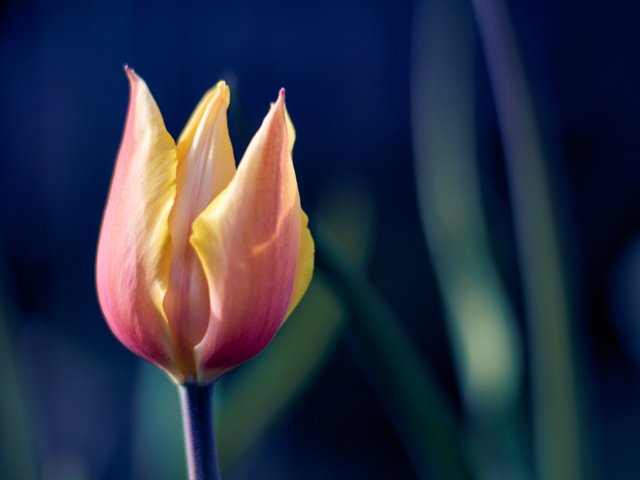
The simple beauty of a tulip in the light contrasts itself against the darkness of the foliage that gives it its life, to follow this metaphor in western terms is counter-intuitive, but in other beliefs and aesthetics the balance is more accepted.
However, the more east you go from Europe the more you encounter cultures that have longstanding culturally aesthetic conventions that are woven into their society. These conventions need not exist as a singularity, and many conventions live pluralistically side-by-side. Some of these conventions are formally tied to religious belief, some exist alongside a religion without being part of it, and some transcend religious divergence. But what they do have is a long-standing codification.
You could spend countless words trying to establish some religious-socio-economic reasoning for the longevity of some of these codifications, alas I would contend it is because they have all grown from a long-standing route of applicable common sense.
If on our route to Japan I will stop off in China to give an example of this practicality via the more commonly known Fung Shi. At the end of the day this is routed in practical application; do you want to sit in a draft, work with the sun in your eyes in a disorganized room, let bad smells waft through your house — and have a roof that is prone to dragon landings. Okay the last one may be a fine example where the practicalities got muddied by romance. But, this does exemplify that these codifications, however they are presented, have a well evolved route that presents a means to a practical end.
When we move further towards the Japan the Shinto-Buddhist concepts begin to underlie the aesthetics and its application into art. To make a westerners sweeping statement about the concept of Shinto-Buddhism; it can be viewed as seeing that the state of everything exists in nature, and in that nature everything is somewhere between its potential, its fulfillment and its return to its potential in the void, like the motion of a wave or a circle that has no end. This flow is the way I picture the elements within the various aesthetic principles and how they can be applied to photographic art through the aesthetics shared concepts of beauty, grace and taste.
So, unlike our western views of aesthetics which are essentially trend based, and which only get codified by emerging artist groups like the Surrealists, Cubists, pre-Raphaelites, Modernists in an attempt to make a stamp of authenticity for their emerging movements (usually before there is a schism that nullifies their manifesto), the Japanese aesthetics are broader ideals that can be applied to the elements of life, be that complex and spiritual, or just to a trendy fashion based westernism.
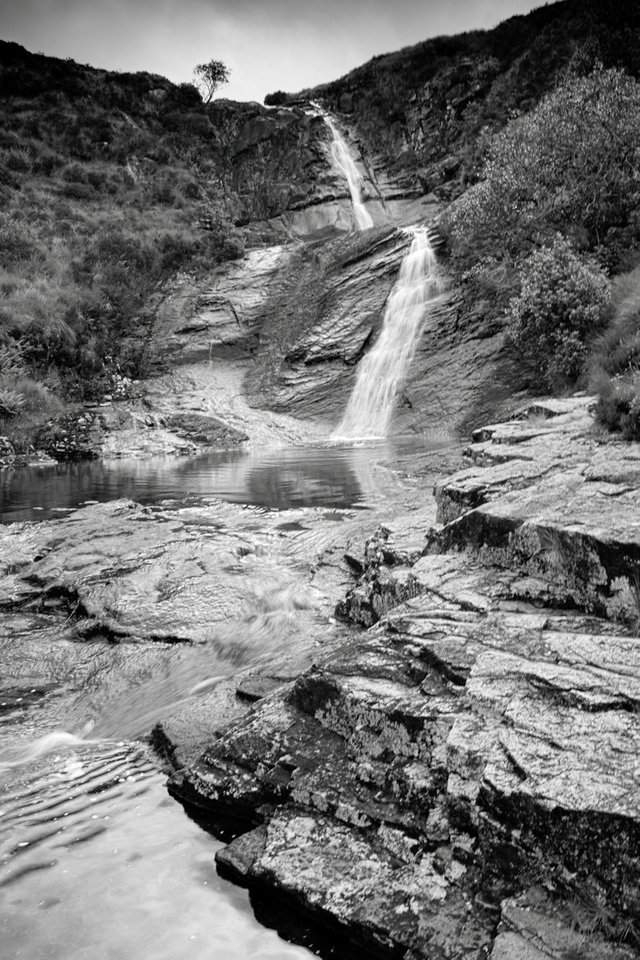
The best line I ever came up with about Skye was; It is the best place in the world where any photographer, at any level, can improved their portfolio by taking less than 50 steps from the road. This is due to Skye’s incontrovertible rugged, haggard and irregular beauty, which is counterpointed by ever-changing sublime light, and in this natural patterning of the present day water against the ancient geological folding adds a depth to the view beyond the first glance. Also I find Skye is effortless Wabi-sabi, and this waterfall is most folks first 50 paces of Skye enlightenment.
As I alluded to above, the Japanese aesthetic, or aesthetics, is not one singular set of rules, but a plurality of guidance constructs on how one should approach life and art. Some of these are to our eyes directly attributable to what we understand as Zen, others appear more straightforwardly applicable as artistic constructs and the ideals that should be sought for in an image. To this end I will move through the main aesthetics from the most straightforwardly applicable, to those that rely on a discipline and a state of mind.
The beauty in imperfection — 佗寂 Wabi-sabi
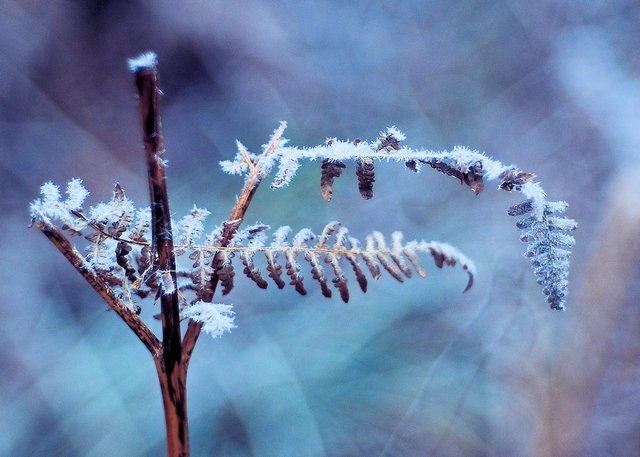
Another image that fulfils the common perceptions of Zen. This image could be described as fulfilling a number of the criteria of Wabi-sabi. What natural symmetry occurs is avoided, so that the leaves are asymmetrical (Fukinsei). The simple story of the winter’s decay is not told in full clarity (Kanso). There is no air that this is staged or manipulated, it is truly natural (Shizen). It is calm and soft and natural in the dusk (Seijaku). And most importantly the rendering of the images story is done with grace and subtlety (Yūgen).
I find this to be the subtlest Japanese aesthetic, its key is in delicately applying its principles and not making a principle element something special that defeats its point. On the whole this principle draws on the trueness of nature itself.
If we return to my metaphor above of the wave we can view the peak of the wave as the pinnacle of its existence, but Wabi and Sabi relate to the thoughtful approach to everyday life, and that the true beauty is not to be found at the peak of the wave but at any other state in its formation or decay. In this the intelligent mind can appreciate these states of beauty that are not the most obvious.
In our wave we can see where the principles that underlie Wabi-sabi exist in a compositional context:
Datsuzoku: The element that ignores the rules, is freehand, irregular, disorganized — otherwise elements that are the opposite of the western stereotypical view of Japan.
Fukinsei: The use of asymmetry and irregularity.
Kanso: That the image is as simple as possible to convey the meaning.
Koko: That the element is raw, basic, weathered — in the way that it has not been enhanced.
Shizen: It is natural in its essence, it is not trying to be something else.
Seijaku: Emoting the feeling of tranquility.
Yūgen: That the point that the image is making is with graceful subtlety, and not in a way that is confrontational, brash or demanding, or indeed obviously. This element also exists as an aesthetics in its own right, which I discuss below.
The human ability for spontaneity and originality — 粋 Iki
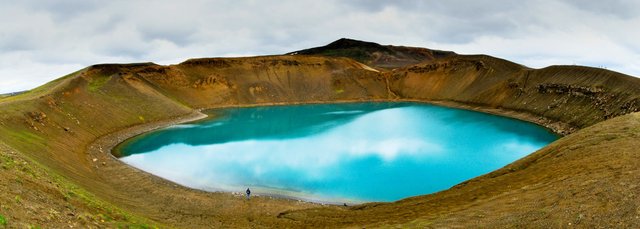
With Images that are drawn from a Japanese aesthetic there is no need to be overtly stereotypical. Anyone who has had the good fortune to visit Iceland will know the key sites can become, well let’s say, not conducive to contemplation. But none the less this image of the Krafla crater complies to the aesthetic elements. It portrays Mono-no-aware within the continual life cycle of Ensō. Its power and potentiality can be seen indirectly on the force it has taken to create Yūgen, as can its scale in the figures in the mid-ground and the distant upper right.
Iki is an aesthetic that is primarily used to describe the human appreciation of natural, or the pure unadulterated beauty or the human form, it is not used to describe nature itself. So with regard it has little direct use in our subject of Landscape Photography. Unless, that is, we are including the human form within our image and as such we are drawing an illustrative parallel from the landscape to discuss the human form. In this case you may have an argument to apply an Iki aesthetic to your work.
Where this would be directly applicable, rather than using the broadly similar Wabi-sabi above (they both shun perfection), is that Iki includes a principle for a tasteful use of sensuality.
The high ideal of elegance — 雅 Miyabi
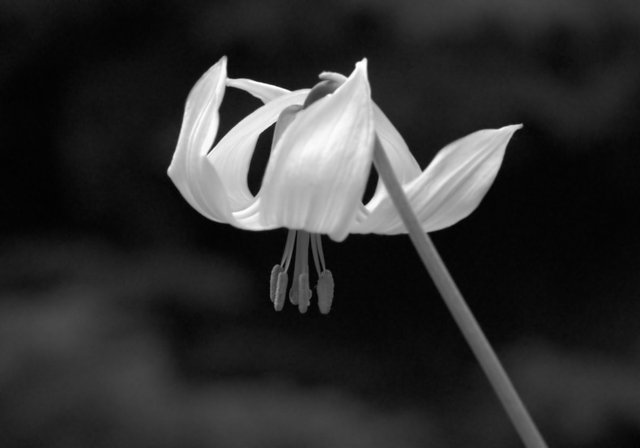
What could be more of a cliché of westerners adoption of Zen than going to Iceland and taking more pictures of flowers than the hard landscape. But this image is one of a series I have been working on that is very Yūgen and Miyabi in approach. A few years back I was trying to buy a With Sympathies card and was confronted by a plethora of stock images of flowers, none of these had any real embodiment of the emotion that the card was meant to express — so I set myself a wee mission to see if I could do better. Commercial probably not, but very satisfying to the inner me.
When you think of the historical high ritual cultural Japan this is the aesthetic you are conjuring up in your mind. However, it is not as predominant in modern Japan as the preceding aesthetics. In my introduction, I eluded to how aesthetics never really became embedded in the west’s culture, due to cultural abuse: the same reasoning could be ascribed to Miyabi. This is because it became the courtly method to exclude all manifestations of vulgarity, from crudity of form to uncomplimentary metaphors. As the wealthy were the only people who could afford the luxury of such lifestyles, there soon became the belief that only upper stratus in society could truly appreciate the Miyabic aesthetic.
However, within Miyabi there is the important principle of Mono-no-aware which I think I can best describe as an appreciation of the beauty throughout a full life-cycle, including its passing, such that a beautiful melancholy is expressed without final resolution being fulfilled. In the west, a parallel can be found in Miles Davis’s motif of not playing the final expected note in a musical phrase.
The simplicity of purpose — 渋い Shibui
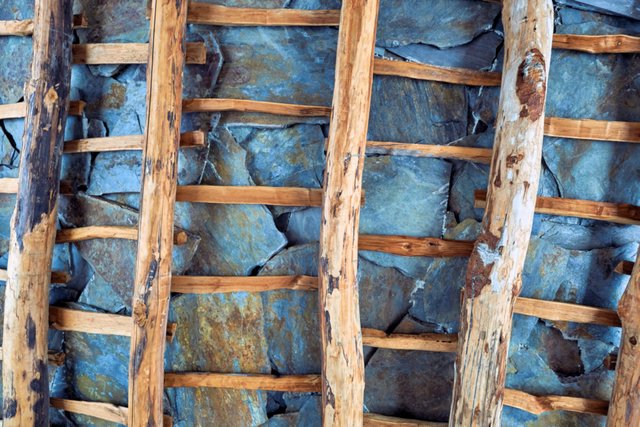
Looking up to a suspended walkway in one of the White Villages in Andalusia shows an often unobserved beauty in the slate and timber structure, even when it purpose is not relieved to the viewer.
This aesthetic sees the simple unobtrusive beauty in culture. The subtle the entity possesses enriches the viewer more with each viewing as the simple subtle details and form are more open to further interpretation than highly detailed forms that point the viewer to specific and definite conclusions.
Where detail does exist it is always within the form and not exaggerated from it; so Shibui could be the patina on metal, the weave in cloth, furrows in a ploughed field. In this way something that conforms to the Shibui aesthetic could conform to Wabi-sabi, but not all in the Wabi-sabi aesthetic will conform to Shibui as metal engraving, embroidered cloth and land sculptures would all be too contrived to conform.
Of the mystical that cannot be easily expressed — Yūgen 幽玄

In the 1980's I helped out a former photographic colleague set-up his screen-print gallery. Some of the material he had for sale was the work of Tetsuro Sawada, who produced highly stylized sunsets, often in a very panoramic form. This captivated me, as at the time photographically sunsets were viewed on as purely the stuff of amateurs, and at that the ones that could only competently do that. Probably from that point on I have never discounted a shot of a sunset on an unprincipled whim, and now I consider them as something that can express the Ensō circle of life effortlessly and as as a lesson in Yūgen.
Where something is present but cannot be seen, might just be the underlying concept of this aesthetic. In other words the ultimate resolution of this aesthetic may very well be that an entities presence is only expressed by the effects of the entity — like the presence of a fish in the water may be the swirls it leaves at the surface.
In written or performed are heavy use is made of nature’s metaphors as description, therefore in photography the elements of nature can be used as a narrative device to describe another story that underlies the pictorial description.
Modulation between movement in three acts — Jo-ha-kyū 序破急

What could be less Zen like than a bright sunny day next to a motorway in post-industrial Scotland. But, if the Japanese aesthetic is all about thinking beyond the obvious in picture creation then this may be more than it appears. In this picture there is a story of three distinct acts; the manual construction and use of a canal, its decline into a post-industrial wasteland, and the rapid transformation to a public leisure resource. So, the elements of Jo-ha-kyū are fulfilled with the narrative that is told in the picture. This would be lost if the pylon, cables and some of the people, cars and signage were removed for a more traditional western ideal.
This aesthetic is definitively physical in its form and relates predominantly to a rhythmic movement pattern that starts slowly, accelerates, then ends abruptly. To us the manifestations we are probably most common with are the highly crafted Japanese Tea Ceremony and the sword based martial art Kendo, though it is native land it is applied directly to Theater and Poetry. Indeed, there are those that are applying its principles to conceptual art.
That being said, in photography there is no reason that the spirit of this aesthetic cannot be applied to the still medium. In this it is perfectly possible to craft an image that encapsulates the essence of these three movement in one image; if not adequately in the three acts of a tryptic. But it is not an aesthetics that I could claim yet to be adept at.
The form and function of the routine — Geidō 藝道
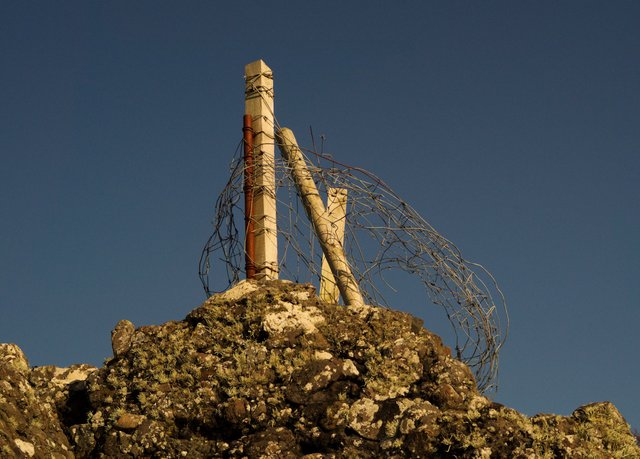
Back in that period in the 1980s I helped the same former colleague mentioned above photograph the deconstructed whiskey barrels of Royden Rabinowitch at Richard DeMarco’s gallery in Edinburgh (my contribution was merely holding the step ladders and my colleague’s ankle while he balanced on tip-toes with an RB67). Talking to Royden was enlightening, but at the time I never really got what-he-was-at; now considering the elements of Japanese aesthetics I do get it. This shot I think sums up what I missed at the time; there is a beauty in the mundane and the elements of Wabi-sabi help in seeing it.
Geidō as it captures system and discipline can also be described as the ritual aesthetic, and like Jo-ha-kyū can be used as a codification for Japanese Tea Ceremony and the sword based martial art Kendo, as well as high art Theater, Calligraphy, Pottery and Flower Arraigning. But, those from the west who have dabbled in Japanese martial arts will be familiar with the prescribed forms of the Kata, where fighting sequences are formally stepped through and formal grading relies of achieving a level of accomplishment.
So photographically we all have proscribed rituals that we step through when we asses a potential image, what Geidō may give us is a concentration that means we consider all aspects in our subject and how we want to resolve it in the final image, without taking shortcuts, or making absent-minded mistakes. To return to the Kata in Karate for a parallel example, this is a list of scenarios of how to deal with various opponent threats, this does not proscribe that when attacked by a swinging sword you must deal with it as in the Kata, merely that you can recall a potential solution with little thought.
Unless you are really dedicated to the ideal of contemplation in harmony with action, it may be best not to think of this too much as a Zen like process. If we observed the practice in Hitsuzendō calligraphy (the way of Zen through a brush), it is believed that unification with the highest reality can be found through the calligraphic practice, and in this the resultant image must breathe with the vitality of the eternal experience. It may be a lot easier to equate this with the more common modern Japanese calligraphy, where the well-proportioned and pleasing to the eye is the achievable goal. But, I know I have on occasion spent endless time meditating a scene before I have brought myself to click the button.
The great circle of everything — Ensō 円相
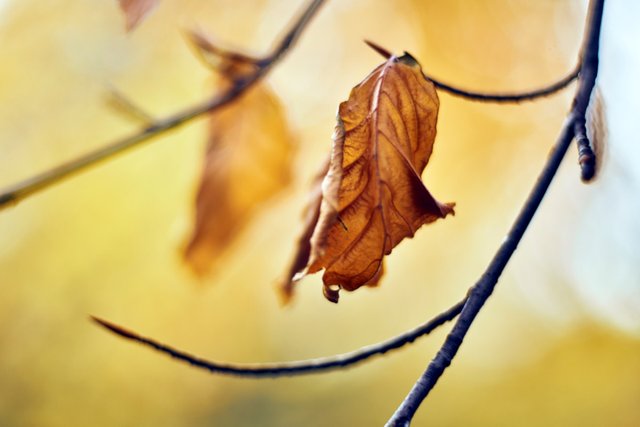
Life goes on as they say, and as an autumnal leaf decays but hangs on to protect next years bud the circle of life continues, the distant mirroring of the subject in the bokeh gives symmetry and an unseen indication that the subject is not alone in this cycle.
If we return to my wave metaphor Ensō is the circle that describes the wave. In this circle we have the absolute of enlightenment, strength, elegance, the universe, and the void (the potential state). To us the most common manifestation is probably the Hitsuzendō calligraphic aesthetic of drawing the Ensō circle itself as mentioned above, in which that artist channels themselves to create a circle that embodies the elements of the aesthetic in one or two brush strokes as a meditative exorcise.
With Ensō all the other aesthetics are captured to some extent, as their bearing has implications on how the practitioner develops in their enlightenment.
To those like me, the barely enlightened westerner, Ensō therefore appeals as a way of consolidating the elements of the other aesthetics, in a way that allows them to be accessible as elements that produce a whole understanding that any process does not have a start and an end, but goes on before and after.
To elaborate this a bit further; the process of taking a photograph is not just from framing the shot to producing the artwork, it is the sum of your life that has brought you to produce the image.
In the western consciousness there springs to mind one discourse that is in this vein:
John Ruskin: “The labour of two days is that for which you ask two hundred guineas?”
James McNeill Whistler: “No. I ask it for the knowledge I have gained in the work of a lifetime.”
In this Whistler was essentially expressing in a western capitalist justification the core of Ensō, as an artist you are drawing on everything you have learned, and if you harness all its collective wisdom you will be capable of producing enlightened art.
So at the end of the day…
…how does all this mysticism help me in my photography?
Well, at the end of the day it makes things simpler by making you think of a concept rather than execute by a formula. To be successful as a photographer you must have an artistic mind, and as an artist you deal natively with concepts as ways to explore and relate, rather than by formulas to repeat and copy. If you think about it this is the difference between an Artist and a Craftsman (yes you can be both). What the Japanese aesthetics give you is a way to explore a method of working that channels you towards an enlightening picture, rather than proscribing that it must be so.
In Wabi-sabi, Miyabi, Shibui and Yūgen we have this mindful guidance of ideals that we can aim for in an image and the illustrative approach.
In Jo-ha-kyū and Geidō we are exposed the more ritualistic aesthetic structures that allow the artistic act itself to become structured, exploring the beauty in the creation of the form as well as the form itself. This is not in the same way as ritualism a graduated filter on every sky, or upping the amber in every autumnal scene, but in ritualizing the thought of considerations that your scene deserves.
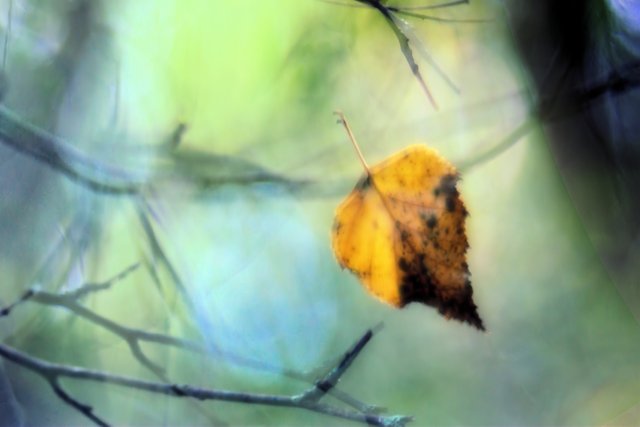
Then in Ensō we appreciate that each image should be viewed in the context of our life’s work, not just as a project, excursion, or capture of a fleeting chance.
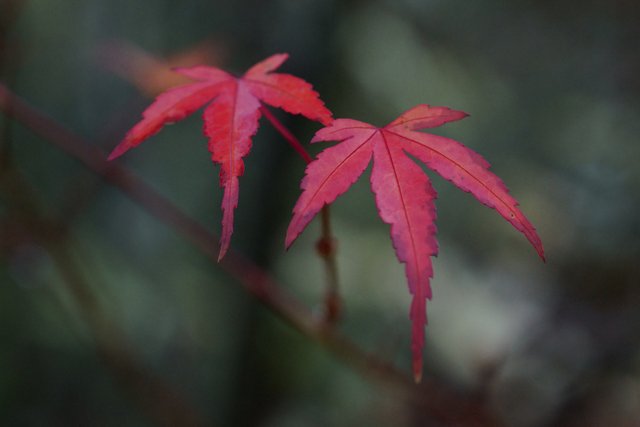
Manually curated by the Qurator Team. Keep up the good work!
Thank you very much - I will try my best.
This post was shared in the Curation Collective Discord community for curators, and upvoted and resteemed by the @c-squared community account after manual review.
@c-squared runs a community witness. Please consider using one of your witness votes on us here
Thank you so much
Congratulations! Your post has been selected as a daily Steemit truffle! It is listed on rank 6 of all contributions awarded today. You can find the TOP DAILY TRUFFLE PICKS HERE.
I upvoted your contribution because to my mind your post is at least 3 SBD worth and should receive 291 votes. It's now up to the lovely Steemit community to make this come true.
I am
TrufflePig, an Artificial Intelligence Bot that helps minnows and content curators using Machine Learning. If you are curious how I select content, you can find an explanation here!Have a nice day and sincerely yours,

TrufflePigThank you very much
Congratulations @scotgillespie! You have completed the following achievement on the Steem blockchain and have been rewarded with new badge(s) :
You can view your badges on your Steem Board and compare to others on the Steem Ranking
If you no longer want to receive notifications, reply to this comment with the word
STOPTo support your work, I also upvoted your post!
Do not miss the last post from @steemitboard:
Vote for @Steemitboard as a witness to get one more award and increased upvotes!
Thank you very much